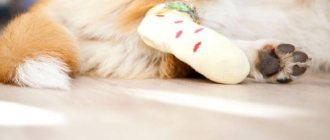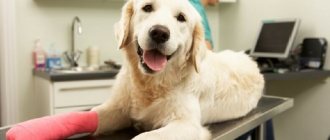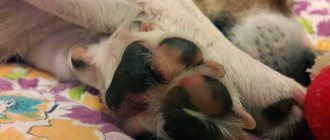Some four-legged pets are born with one extra toe that they do not use, and some have even more. Most often it forms on the front legs, but sometimes it occurs on the hind legs.
In the latter case, the additional shoot greatly worries owners who plan to present their pets at exhibitions. The most obvious solution in such cases seems to be surgery, but this is always associated with risks. There must be a compelling reason for surgery and a veterinarian should be consulted.
How many toes should dogs have on their paws?
Most dogs have 5 phalanges of toes on their front paws and 4 on their hind paws. In front, one of them is slightly set aside. This is the so-called dewclaw, which is very similar to the human thumb. The difference is that this process is just a rudiment. Sometimes animals use it for capture, but generally it is practically useless.
Interesting Facts
Breeds originally bred in cold countries (such as St. Bernards and Newfoundlands) have a special toe structure. They are long and very flexible. Newfoundlands hold the record for the longest toes among all dog breeds, with Labradors in second place.
It is also interesting that there are leathery membranes between the fingers of both varieties. However, the latter are not unique: there are about three other dog breeds in the world that also have webbed formations between their toes.
Some varieties of dogs have what are called “cat paws.” In this case, the last bone of the finger is shortened, the paw itself is much more compact. Dogs with this “design” of legs are much more resilient, since their body weight is more evenly distributed over the surface. The following dog breeds are distinguished by “cat legs”:
- Doberman pinschers.
- Giant Schnauzers.
- Newfoundland.
- Airedale.
- Bull Terrier.
- Finnish Spitz.
- English Shepherds.
But it’s not just “cats” who are among the dogs! Some breeds have paws that are called “hare paws” because the two middle toes protrude far forward. Many “pocket” dogs, Samoyed huskies, Bedlington terriers, Skye terriers, all greyhounds and hounds have such paws. Thanks to this foot configuration, many of the dogs listed above have good running abilities.
Dog dewclaws: normal or pathological?
The dewclaws on the front paws of dogs are securely attached. They are held by as many as 3 phalanges. They do not cause problems, so this phenomenon is considered normal.
With dewclaws, which are located on dogs' hind legs, everything is different. They were inherited by four-legged pets from their distant ancestors - wolves, but have long lost their functionality. Their main drawback is the frequent absence of a phalanx. Basically, the nail processes are attached to the skin directly or with the help of 1-2 phalanges. Because of this, they are often injured.
The profit rudiment is a dominant trait that is inherited. If at least one of the parents has it, then their puppies will definitely inherit it.
Jaw fracture
These fractures in dogs are extremely rare, but if a dog's jaw fracture does occur, such injuries require very close attention. Typically, such fractures are open; numerous bacteria from the oral cavity can penetrate through the mucosal defect into the thickness of the jaw, so such fractures must be treated as soon as possible. They usually happen during fights with other dogs, as a result of a car injury, or if the dog crashes its head into an obstacle. An additional risk factor is old age and poor oral health (gingivitis, periodontitis). With these diseases, the jaw bone becomes weak and can easily break with minimal impact. We must also warn that jaw fractures in small dogs sometimes occur when owners and unscrupulous veterinarians try to remove their baby teeth without anesthesia. We categorically do not recommend doing this; the animal will defend itself so energetically that it can harm itself.
Symptoms of a jaw fracture include severe pain, inability to close or open the mouth, inability to eat, an asymmetrical appearance of the muzzle, and bleeding from the mouth. To treat such fractures, surgery is required: osteosynthesis with a plate, knitting needles or wire sutures, depending on the location of the fracture and the size of the dog. Within a day after the operation, the dog will be able to eat soft food and will quickly recover.
You can contact our veterinary center regarding any type of fracture in your dog. To do this, you do not need to make an appointment with a surgeon or traumatologist. Bring your dog to any general practitioner every day from 10.00 to 22.00. He will conduct an examination, provide pain relief, evaluate associated problems, take x-rays, and record the fracture until the time of surgery.
If you have already been examined and want to undergo osteosynthesis in our clinic, you can sign up for the operation and ask all your questions by calling us at the Veterinary by phone.
Should a dog's 5th toe be removed?
A dewclaw is not a pathology. It does not affect health, since the dog’s body is adapted to it. Despite this, the rudiment requires special care and can cause some inconvenience to the animal.
In Europe, amputation requires serious reasons, but in Russia it is resorted to at the request of the owner. In the absence of medical indications, it is not mandatory, so it is recommended to weigh the pros and cons before making a decision.
Functionality of the extra toe in dogs
The 5th finger in dogs makes it easier to hold toys, bones and other objects, but only if it is located in front. The rudiments on the hind legs do not perform this function. They look more protruding, so animals often cling to everything with them while walking outside.
Participation in exhibitions and competitions
At dog shows, extra claws are considered a serious defect, so if they are present, a show career and international competitions are prohibited. If the animal belongs to the breeding or show class, then its rudiments must be amputated. Exceptions include only a few breeds:
- Pyrenean Mastiffs;
- briards;
- Beaucerons;
- Nenets huskies;
- Turkish Kangals.
In the dogs listed above, four-toed dogs are recognized as a defect. For this reason, you should not rush into surgery if you are not sure about the specifics of your pet's standard.
In addition to participating in exhibitions, good reasons for removal include hunting and active sports. In both cases, the extra claws can get caught on branches or other objects, causing the animal severe pain and reducing its running speed.
Animal safety and care
The fifth toe in dogs on their hind legs is not attached to the body by muscles and cartilage. His frequent injuries are due to his high mobility. The risk group includes pets that love running and active games. Stuck in another hole, they can easily earn a fracture by deciding to sharply pull out the paw that has fallen into the trap.
It is also worth mentioning the risk of injury due to the owner’s negligence. Small breeds and puppies usually suffer from falling heavy objects and being pinched by doors.
Problems also arise with care. An additional claw significantly complicates grooming, since during a haircut it can be accidentally cut off due to negligence.
What if you don't delete it?
Removing the dewclaw in dogs serves to prevent injuries and related complications. If in the process of life it causes constant inconvenience, then refusal of surgical intervention can lead to the following consequences:
- inflammation and ingrown claws;
- phalangeal fractures;
- osteomyelitis and osteosarcoma;
- paw gangrene and various necrotic formations.
If you have any doubts, be sure to consult your veterinarian. He will help determine the need for surgery, based on the breed and lifestyle of the animal.
How to spot pregnancy symptoms in a cat
Behavioral and physiological signs that a cat is pregnant appear soon after mating. Despite this, examination at a veterinary clinic is considered the most accurate diagnosis.
Early on
The first symptoms are increased drowsiness and decreased appetite. Active pets become lethargic and refuse to eat due to nausea. It is also possible for an early cessation of estrus and a change in pigmentation of the nipples to a more intense shade.
All these changes do not give a 100% guarantee and manifest themselves individually. If your pet does not eat for more than a day due to frequent bouts of vomiting, consult a doctor. This condition is not typical for a pregnant animal and indicates the presence of a disease.
At the veterinary clinic
If you know how to determine a cat’s pregnancy in the early stages, then do not be guided only by your own conclusions. In addition to the small guarantee of the symptoms seen, there remains the possibility of false pregnancy, which threatens the health of the animal. To confirm or refute this diagnosis, you must contact your veterinarian.
Make an appointment at the veterinary clinic for 20-25 days after mating. By this time, the placenta releases relaxin into the blood - a hormone that confirms the successful fertilization of the egg and is an analogue of human chorionic gonadotropin (hCG hormone). With cystic formations in the ovaries, the result may be false positive.
In addition to taking tests, the veterinarian performs an external examination and palpation of the animal. An ultrasound is performed to detect the fetuses, and an x-ray is used to determine their exact number and position. An X-ray is recognized as the most accurate diagnostic method, but is carried out no earlier than 50 days after mating.
At home
You can determine if a cat is pregnant at home by both behavioral and physiological signs. Unlike symptoms, which appear early, signs are a group of factors characteristic of a particular condition. That is, the appearance of certain symptoms is not always associated with successful conception and may indicate a disease.
The first signs of pregnancy in a cat appear on the 28th day after mating. The expectant mother's belly becomes rounder, her nipples swell, and her weight increases. The kittens begin to move inside the rounded belly. They can be felt by palpation, but veterinarians recommend avoiding this diagnostic method. Applying too much pressure can cause miscarriage, so leave palpation to an experienced veterinarian.
At what age is the fifth toe amputated in dogs?
It is recommended to resort to surgical intervention as early as possible. Ideally, it should be combined with cupping, if it is necessary according to the standard. At a young age, anesthesia is easier to tolerate and wounds heal much faster.
In puppies
It is recommended to remove dewclaws from puppies 3-6 days after birth. Starting from 1 week of life and up to 16, surgery is temporarily prohibited.
Most often, they resort to it only after reaching a year. This is due to the fact that in the first days, local anesthesia is enough for puppies, and on the 7th day they have to resort to general anesthesia. For this reason, the baby must grow up and get stronger in order to avoid unpleasant consequences associated with anesthesia.
In adult animals
After a year, amputation becomes more difficult, which affects its cost and rehabilitation period. And while puppies are often operated on right at home, adult animals are operated strictly in a veterinary clinic.
Hygiene issues
Paws require special care, no matter how many toes a dog has. Hygiene issues become important when dogs live in the same premises as their owners. The animal must be walked twice a day in all weather conditions, which include bacteria, dirt and dust.
Dirt, dust and small particles can be absorbed into the skin and harm the pet's health. This means that it is not enough to simply wipe the dog’s paws with a dry cloth; a thorough wash is necessary.
Only proper and regular care will ensure good health for your pet.
Removal procedure
The procedure for using anesthesia, direct amputation and the rehabilitation period depend on the age of the pet. On average, recovery takes about a week.
Introduction to general anesthesia
General anesthesia is used strictly after reaching 16 weeks. It not only anesthetizes, but also immobilizes, facilitating various manipulations.
Drug-induced sleep begins approximately a minute after the administration of anesthesia and lasts from 1 to 3 hours. The operation itself takes only 20 minutes, so after it is performed, the four-legged patient is left in the hospital until he wakes up.
Amputation
Babies are numbed with local anesthesia. From 3 to 6 days after birth, the blood flows weakly, so the surgeon simply takes the puppy in his arms and cuts off the excess appendage with medical scissors. The resulting wound is stitched with self-absorbing threads and hidden under a sterile bandage. After all the manipulations, the baby is immediately given to the mother.
Removal of fifth toes in adult dogs and puppies over 16 weeks of age is performed under general anesthesia with mandatory fixation on the operating table. The four-legged patient is placed on his left side or stomach. The rudiment is removed with a scalpel, and a tight suture is fixed on the resulting wound.
Aftercare
Regardless of age, the animal needs time to recover. Within 7 days the owner will have to:
- Regularly cleaning your pet's rest room, not forgetting about wet cleaning, is protection against infections.
- Change the bandage daily and monitor the condition of the wound. If you notice traces of pus, swelling, fever, bleeding or an unpleasant odor, you should call the veterinarian as soon as possible.
- Avoid interaction with the operated paw.
- Put the dog on a gentle diet to avoid increased stress on the gastrointestinal tract. Only recently born puppies do not need to change their diet. In their case, constant access to breast milk, on the contrary, is welcomed.
The healing wound is very itchy, so it is recommended to use an Elizabethan collar until it is completely healed. It will prevent damage to the seam during scratching and licking.
What operations are there?
Any osteosynthesis is carried out using metal structures, with the help of which bone fragments are fixed to each other. These structures can be placed inside the bone (pins, wires), pass through the bone (screws, screws, wire sutures) or fixed on its surface (plates). There are also methods for fixing fractures, in which the wires pass through the bone fragments, and the main structure that ensures the strength of their connection is located outside the limb (Ilizarov apparatus and other external fixators).
Osteosynthesis is performed under general anesthesia. The choice of design depends on the type of fracture and associated soft tissue injuries. At our veterinary center, we specialize in complex fractures (comminuted, crushed, multifocal, gunshot) and have all the necessary equipment and experience to treat them, including using external fixators and the Ilizarov apparatus. Many cats and dogs, which in other clinics were offered limb amputation due to complex fractures, have retained their limbs thanks to the joint efforts of our doctors and their owners.
What can a dog's paw do?
The functions of dog paws can be analyzed using the example of its components:
- Claws . Compared to human nails, a dog's or even a puppy's claws are thicker and stronger, making it easy to dig holes and maintain stability. Its direct purpose (killing prey) is rarely used, since the role of a companion does not imply an independent search for food.
- pads. Indispensable as:
- Shock absorbers . They reduce the load on bone tissue, help with sudden braking, maintain stability and protect joints from wear.
- Hot water bottles . The presence of blood vessels protects against hypothermia, but makes the animal vulnerable to hot asphalt.
- Sweating regulator . Sweat glands, located in the inner layer, moisturize the skin and allow you to mark objects and territory.
- Fingers . They perform the function of human heels and take the main load during movement. The finger located next to the wrist is called the dewclaw and is used for grasping and holding objects.
A dog's paw consists of claws, toes and pads.
Peculiarities
Among the features characteristic of dog paws are:
- Lack of ability to hide claws and move fingers.
- A special manner of movement . Animals walk on their toes, avoiding contact of their heels and wrists with the ground.
- Ability to produce a sweet popcorn aroma . This is due to bacteria formed by wet microflora on sweaty pads and is observed in decorative dogs that rarely go outside.
- Expression of fear through sweat glands . Four-legged friends are also capable of experiencing a state of “cold sweat”. The secret they leave is also read by other dogs, who take over the underlying anxiety.
- The presence of a special system of arteries that heat frozen blood and regulate a constant temperature. Even -35 degrees is not scary for dogs. Only dolphins and penguins can boast of such abilities.











